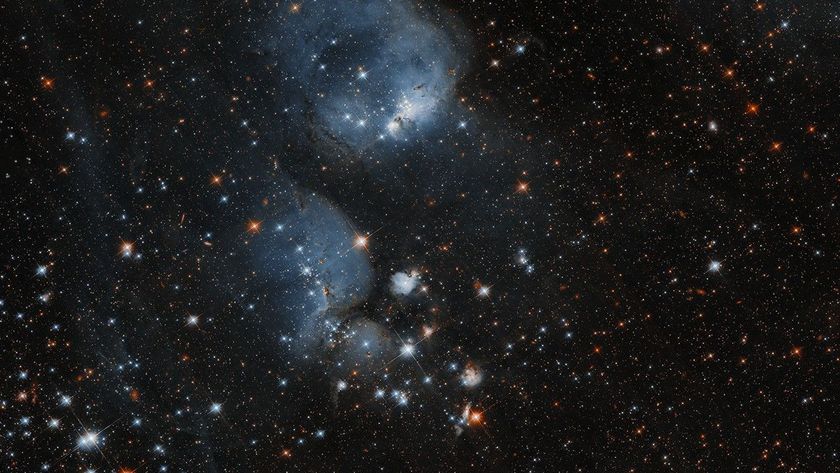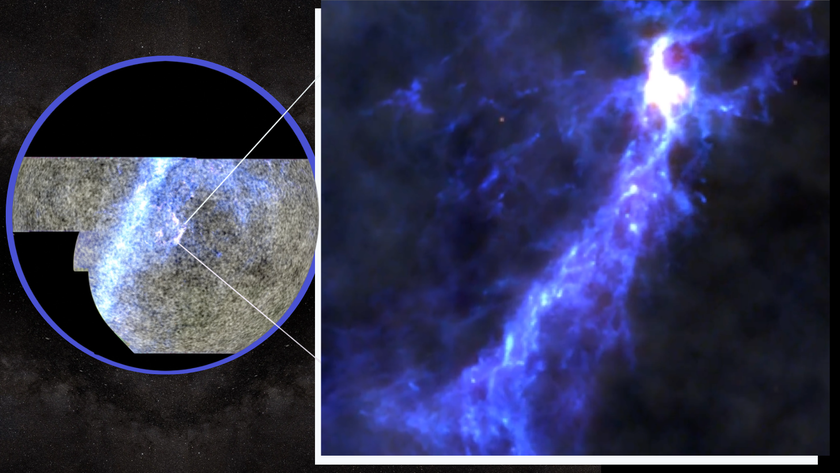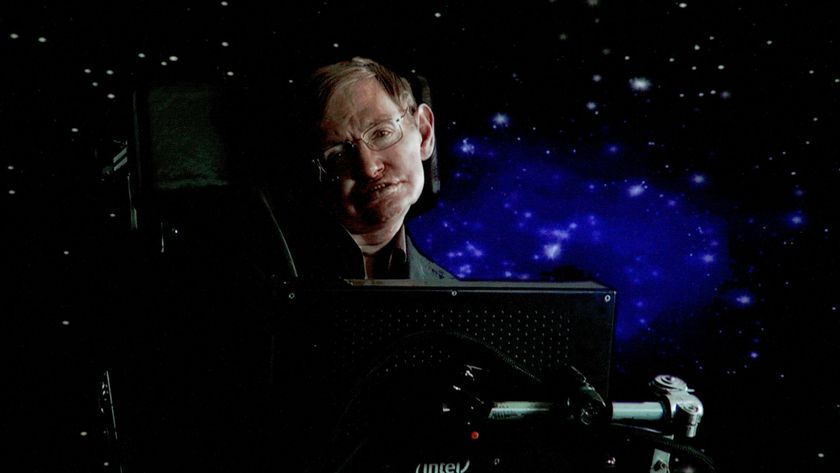What?! The Universe Appears to Be Missing Some Light
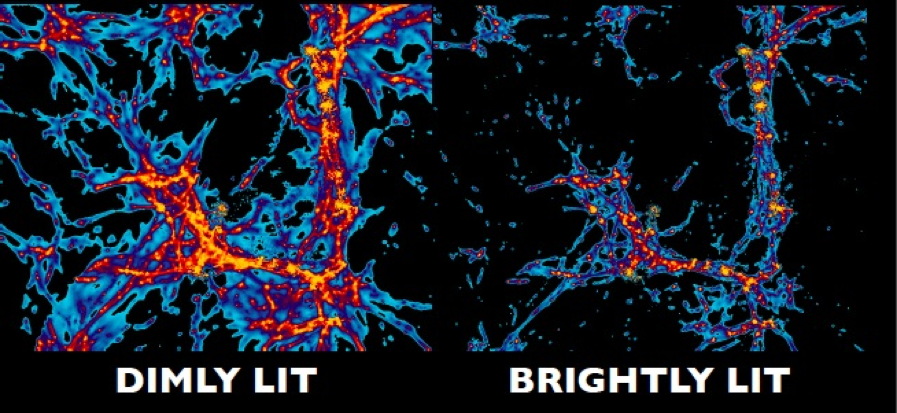
An extraordinary amount of ultraviolet light appears to be missing from the universe, scientists have found.
One potential source of this missing light might be the mysterious dark matter that makes up most of the mass in the cosmos. But a simpler explanation could be that ultra violet light escapes from galaxies more easily than is currently thought, according to the new research.
This puzzle begins with hydrogen, the most common element in the universe, which makes up about 75 percent of known matter. High-energy ultraviolet light can convert electrically neutral hydrogen atoms into electrically charged ions. The two known sources for such ionizing rays are hot young stars and quasars, which are supermassive black holes more than a million times the mass of the sun that release extraordinarily large amounts of light as they rip apart stars and gobble matter. [See images of black holes in the universe]
![Black holes are strange regions where gravity is strong enough to bend light, warp space and distort time. [See how black holes work in this SPACE.com infographic.]](https://cdn.mos.cms.futurecdn.net/8GbuLi8DVtx8HoZeSyndT7-320-80.jpg)
Astronomers previously found that ionizing rays from hot young stars are nearly always absorbed by gas in their home galaxies. As such, they virtually never escape to affect intergalactic hydrogen.
However, when scientists performed supercomputer simulations of the amount of intergalactic hydrogen that should exist and compared their results with observations from the Hubble Space Telescope's Cosmic Origins Spectrograph, they found the amount of light from known quasars is five times lower than what is needed to explain the amount of electrically neutral intergalactic hydrogen observed.
"It's as if you're in a big, brightly-lit room, but you look around and see only a few 40-watt lightbulbs," lead study author Juna Kollmeier, a theoretical astrophysicist at the Observatories of the Carnegie Institution of Washington in Pasadena, Calif., said in a statement. "Where is all that light coming from? It's missing."
The researchers are calling this giant deficit of ultraviolet light "the photon underproduction crisis."
Get the Space.com Newsletter
Breaking space news, the latest updates on rocket launches, skywatching events and more!
"In modern astrophysics, you very rarely find large mismatches like the one we are talking about here," Kollmeier told Space.com. "When you see one, you know that there is an opportunity to learn something new about the universe, and that's amazing."
"The great thing about a 400 percent discrepancy is that you know something is really wrong," study co-author David Weinberg at Ohio State University said in a statement. "We still don't know for sure what it is, but at least one thing we thought we knew about the present day universe isn't true."
Strangely, this missing light only appears in the nearby, relatively well-studied cosmos. When telescopes focus on light from galaxies billions of light years away — and therefore from billions of years in the past — no problem is seen. In other words, the amount of ultraviolet light in the early universe makes sense, but the amount of ultraviolet light in the nearby universe does not.
"The authors have performed a careful and thorough analysis of the problem," said theoretical astrophysicist Abraham Loeb, chairman of the astronomy department at Harvard University, who did not take part in this research. [See amazing images of galaxies]
The most exciting possibility these findings raise is that the missing photons are coming from some exotic new source, not galaxies or quasars at all, Kollmeier said. For example, dark matter, the invisible and intangible substance thought to make up five-sixths of all matter in the universe, might be capable of decay and generating this extra light.
"You know it's a crisis when you start seriously talking about decaying dark matter," study co-author Neal Katz at the University of Massachusetts at Amherst said in a statement.
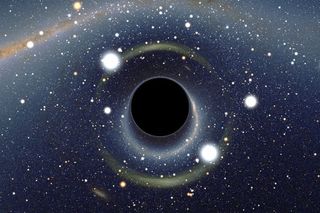
Nearby, recent "low-redshift" galaxies have less gas to absorb ultraviolet rays that more distant, early "high-redshift" galaxies, Loeb noted.
"The more I think about it, the more plausible it appears that the escape fraction of ultraviolet photons is higher in local galaxies than in high-redshift galaxies," Loeb said.
On the other hand, "the biggest problem with this possible solution is that there are measurements of local galaxies that indicate the average escape fraction is significantly lower than 15 percent — more like 5 percent," Kollmeier said."In principle, it is possible that these galaxies are not representative and therefore we need to do more such measurements, but we cannot just dismiss the data."
Another potential explanation is ionization of intergalactic hydrogen by x-rays and cosmic rays, Loeb said. Although he noted this radiation does not play a major role in ionizing intergalactic hydrogen in the most distant corners and earliest times in the universe, astronomers may want to see how much of a role x-rays and cosmic rays play in the nearby universe, "where they are produced more vigorously," he said.
The scientists detailed their findings in the July 10 issue of the Astrophysical Journal Letters.
Follow us @Spacedotcom, Facebook and Google+. Original article on Space.com.
Join our Space Forums to keep talking space on the latest missions, night sky and more! And if you have a news tip, correction or comment, let us know at: community@space.com.

Charles Q. Choi is a contributing writer for Space.com and Live Science. He covers all things human origins and astronomy as well as physics, animals and general science topics. Charles has a Master of Arts degree from the University of Missouri-Columbia, School of Journalism and a Bachelor of Arts degree from the University of South Florida. Charles has visited every continent on Earth, drinking rancid yak butter tea in Lhasa, snorkeling with sea lions in the Galapagos and even climbing an iceberg in Antarctica. Visit him at http://www.sciwriter.us
